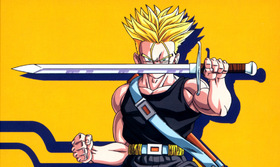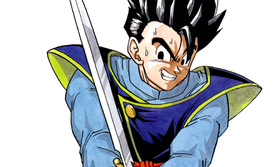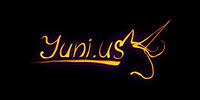
 DRAGON BALL Shitajiki
DRAGON BALL Shitajiki
This is a Roman gladius, short sword classification, most favored by the Phalanx style legionnaire approximately 2 thousand + years ago at the Height of Caesar’s campaign to rule the planet
 Artbook : DRAGON BALL Daizenshuu
Artbook : DRAGON BALL Daizenshuu
This is hand and half bastard classification, European style weapon. It’s the lighter and shorter of the Bastard class, and is a Sub-division of full sized bastard class swords. Though Trunks weapon isn’t the typical wire and leather wrapped handle that is classical to the Agincourt sized weapons, as it is normally found in modern times, nor twisted wire only wrapped which is also found in museums, the name of the other two major campaign challengers for the title are the same size, and their names are escaping me at the moment. So consider the Agincourt to be a generic terms of sorts.
 Artbook : DRAGON BALL Daizenshuu
Artbook : DRAGON BALL Daizenshuu
This is a full length bastard class sword, so is a bit longer and thicker of Tang, And Temper line as is clearly seen if you look at the thickness of the weapon versus the Hilt and Guard sections of the weapon.. The Guard is one that is traditionally used on full sized bastard
class, not the lighter hand and half.
Notes for those who have no idea what a sword is made up of :
#1 Pommel- the cap thing on top that keeps the Hilt, guard and blade aligned correctly.. Often screwed onto the long Tang of the Blade after the guard and then Hilt were placed upon the tang section of the weapon’s blade.
#2 Guard (as in protect hands) is the thing just on top of the sharp pointy part you stick, slice, or dice things with.
#3. Tang: this is the point where the blade itself ends in a long, thin, boxy kind of block from the main metal forged into the weapon.. there are rectangular or foil styled square tangs.. the longer the tang was the heavier and thicker the sword generally was.. Rectangular blocks were the main style for Broadswords and full bastard class. The thinner rectangle form for Hand and Half class Bastards to the heavier styled Scimitar and other large bladed short swords (favored in the Arab nations mostly, or by pirates in Hollywood’s eyes. ~> Snickering)
Thin Foil tangs were very boxy squares, but long, endings to a much lighter sword, like the modern fencing style Rapier, or Foil practice weapons…. or like a legionnaire’s short sword of Roman empire days..
#4. The Hilt is the handle portion you actually grab onto. The short hilts will only allow a single hand to be used to handle the weapon, but larger sized weapons have longer hilts..
The really big monsters, like the 11 pounds plus, 6 foot long or longer, Claymores aka Broad Sword class…. were a leather wrap only hilt due to the frequent need to replace the leather so the hilt’s leather wouldn’t get too rotten causing a person to lose their weapon in a fight.. (if not legs and toes in the process along with their head as the opponent sliced and diced the newly unarmed opponent up.)
Hand and Half or Bastard class main were either leather wrap, or leather and wire wrapped.. The Agincourt calass was the first Wire only wrapped hilt.. (Nobility made Agincourts the rage due to the ability for them to go through lots of Gauntlets… ( Gloves with chain mail sewn between the layers of heavy padded leather normally) since they could afford the wear and tear the braided, thin wire only hilts caused on the hands that wielded them…
Tang only hilts were the shortest lightest swords of the classical through renaissance era, and they were usually capped with a pommel that was of a gem cup variety, as this type pommel was usually referred too.. Normally, these were leather only styles of hilt preparation as they had very thin, foil like tangs instead of thick, rectangle blocks for tangs that larger swords would have to have in order to put a guard or hilt onto the weapon to protect the hands of the fighter, and to insure a descent grip purchase. The guard ring would be the only thing really needed, but the pommel in this case, though only a decoration, still acted as a guide… crew down pommels fit the ends.. While heavier gage pommels were normally a hammer on and then stick a hot iron pin through the holes hand drilled into the tang, and very tip of hilt for a fold over job…

